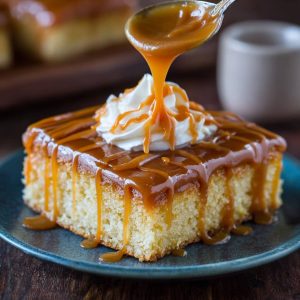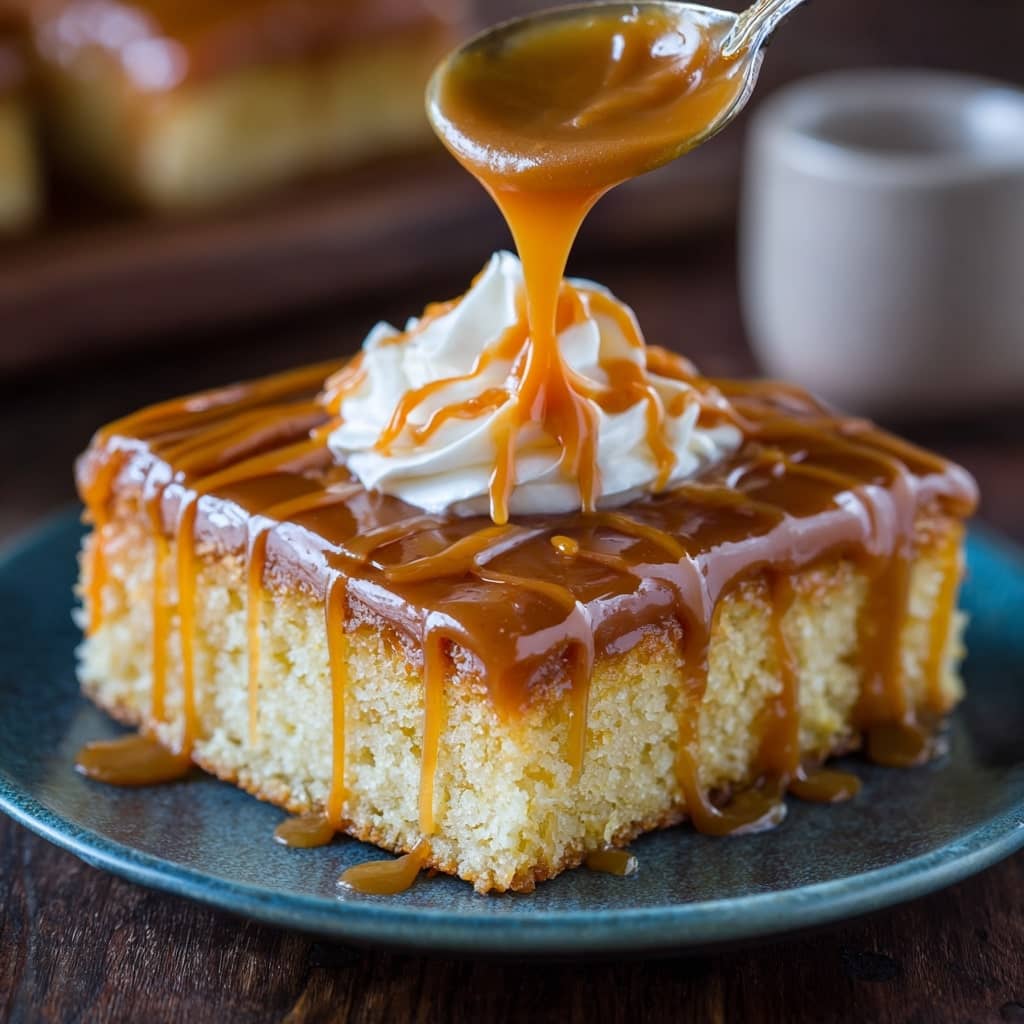Introduction
The Easy Caramel Sheet Cake is a rich, buttery dessert that offers the luxurious flavor of caramel in a simple, fuss-free format perfect for everyday indulgence or crowd-pleasing events. With its soft, tender crumb and silky caramel glaze that soaks into the top layer, every bite delivers deep caramel flavor balanced by a moist and fluffy texture. Unlike layer cakes that require multiple steps and assembly, this sheet cake bakes in a single pan, making it ideal for casual dinners, potlucks, bake sales, or family celebrations. The ease of preparation doesn’t compromise the taste—it’s decadent, comforting, and irresistibly satisfying. Whether served warm or at room temperature, with a scoop of vanilla ice cream or a sprinkle of sea salt, this cake is pure caramel bliss in its simplest form.
The History of Caramel Sheet Cake
Caramel desserts have long roots in European confectionery, with early caramel sauces developed in France and England as far back as the 17th century. Over time, caramel evolved from a simple sugar confection to a rich component in cakes, puddings, and sauces. The sheet cake format, on the other hand, has deep American roots, particularly in the South and Midwest, where large gatherings called for easy-to-serve, big-batch desserts. In the 20th century, as ovens and baking ingredients became more accessible, home bakers began fusing caramel flavors into sheet cakes, taking inspiration from traditional Southern caramel layer cakes but eliminating the complex assembly. The Easy Caramel Sheet Cake was born out of this need for efficiency and flavor, becoming a beloved staple for birthdays, holidays, and everyday treats. It has since seen countless adaptations but remains treasured for its simplicity and nostalgia.
Ingredients Breakdown
For the Cake: 2 cups all-purpose flour, 1 teaspoon baking soda, 1/2 teaspoon salt, 1 cup unsalted butter, 1 cup water, 1/2 cup sour cream or plain Greek yogurt, 2 large eggs, 1 and 1/2 cups packed light brown sugar, 1 teaspoon vanilla extract. For the Caramel Icing: 1/2 cup unsalted butter, 1 cup packed brown sugar, 1/4 cup milk or heavy cream, 2 cups powdered sugar (sifted), 1/2 teaspoon vanilla extract. Optional Add-Ons: chopped pecans or walnuts, flaky sea salt, whipped cream, or ice cream for serving.
Step-by-Step Recipe
Preheat the oven to 350°F (175°C) and grease a 9×13-inch baking pan or line it with parchment paper. In a large mixing bowl, whisk together the flour, baking soda, and salt; set aside. In a medium saucepan, combine the butter and water, and bring to a boil over medium heat, stirring until the butter melts. Remove from heat and stir in the brown sugar, then allow it to cool slightly. In a separate bowl, whisk together the eggs, sour cream, and vanilla. Add the egg mixture to the butter-sugar mixture, then gradually stir in the dry ingredients until the batter is smooth. Pour the batter into the prepared pan and spread evenly. Bake for 25–30 minutes, or until a toothpick inserted into the center comes out clean. Let the cake cool slightly in the pan. While the cake is cooling, prepare the icing. In a medium saucepan, melt the butter over medium heat, then add the brown sugar and stir until dissolved. Add the milk or cream and bring the mixture to a gentle boil, then remove from heat. Stir in the vanilla and gradually whisk in the powdered sugar until smooth and glossy. Pour the warm caramel icing over the slightly warm cake, spreading it evenly with a spatula. Let the icing set before slicing and serving.
Tips for the Perfect Cake
Always measure your flour correctly by spooning it into the cup and leveling it off—don’t pack it in, or the cake may become dense. Use fresh brown sugar to ensure a deep, molasses-like caramel flavor. Let the butter mixture cool slightly before adding the eggs to avoid scrambling them. Stir the icing continuously while cooking to prevent graininess, and sift the powdered sugar for a smooth finish. For extra decadence, serve the cake warm with a scoop of vanilla or butter pecan ice cream. If you want to prepare it ahead of time, wait until just before serving to make and pour the icing for a fresher finish.
Variations and Customizations
Nutty Caramel Cake: Add 1 cup of chopped toasted pecans or walnuts to the batter or sprinkle over the frosting. Salted Caramel Version: Stir sea salt into the icing or sprinkle flaky sea salt on top after glazing. Spiced Caramel Cake: Add 1/2 teaspoon cinnamon and 1/4 teaspoon nutmeg to the dry ingredients for a warm autumn twist. Chocolate Caramel Sheet Cake: Swirl melted chocolate into the batter or top the finished cake with chocolate chips. Coconut Caramel: Mix shredded coconut into the batter or toast it for a crunchy topping. Mini Sheet Cakes: Bake the batter in two 8×8-inch pans or use cupcake pans for individual servings. Dairy-Free Adaptation: Use dairy-free butter and coconut milk as substitutes to make a dairy-free version. Gluten-Free Option: Replace flour with a 1:1 gluten-free baking mix.
Health Considerations and Nutritional Value
While delicious and comforting, this cake is high in sugar and fat, especially due to the caramel icing. A typical serving can range from 300–450 calories depending on portion size and toppings. To make a lighter version, use Greek yogurt in place of sour cream, reduce the amount of brown sugar slightly, or try a sugar substitute for part of the icing. Choose whole grain flour for added fiber if desired. Nuts can provide healthy fats and a nutritional boost, but they’ll also increase calorie content. Portion control is key—this cake is meant to be a treat, not a staple, and best enjoyed in moderation or for special occasions.
FAQ
Can I make this ahead of time? Yes, the cake can be baked a day ahead, but it’s best to add the icing shortly before serving. How do I store leftovers? Cover tightly and store at room temperature for up to 3 days, or refrigerate for up to 5 days. Can I freeze this cake? Yes, freeze the unfrosted cake for up to 2 months; thaw completely before adding icing. What can I use instead of sour cream? Plain full-fat Greek yogurt or buttermilk works well. Is this cake overly sweet? The icing is rich, but the cake itself is balanced—reduce sugar in the icing for a less sweet version. Can I use store-bought caramel sauce? For the icing, it’s best to make your own, but a thick store-bought sauce could work in a pinch. Can I double the recipe? Absolutely—just use a larger sheet pan and adjust the baking time accordingly.

Easy Caramel Sheet Cake
Ingredients
Caramel Cake
- 2 cups 250 g all-purpose flour
- 1/4 cup 30 g cornstarch
- 2 and 1/2 teaspoons baking powder
- 1/2 teaspoon salt skip if using salted butter
- 3/4 cup 170 g unsalted butter, at room temperature
- 1/4 cup 55 g neutral vegetable oil (such as canola oil)
- 1 cup 200 g white granulated sugar
- 1/2 cup 100 g light brown sugar, soft
- 3 large eggs at room temperature
- 1 tablespoon vanilla extract or essence
- 1/2 cup 120 g sour cream, at room temperature
- 1/2 cup 120 g full-fat milk, at room temperature
Caramel Frosting
- 3/4 cup 170 g unsalted butter, softened to room temperature
- 1 and 1/2 cups 300 g white granulated sugar
- 2 cups 510 g evaporated milk (equivalent to 1 and 1/2 standard 12 oz/340 g cans)
- 1/4 teaspoon salt omit if using salted butter
- 1/3 cup 80 g cream, at room temperature (any type—whipping, heavy, or similar)
- 1 and 1/2 teaspoons vanilla extract or essence
Instructions
Caramel Cake
- Preheat your oven to 160°C (320°F) with the fan setting on (refer to note 1 if your oven doesn’t have a fan function), and grease or line two 8-inch cake pans (homemade cake release works well).
- In a medium bowl, sift together the flour, cornstarch, baking powder, and salt. Use a whisk or fork to mix thoroughly until the dry ingredients are well combined, then set aside.
- In a large mixing bowl, combine the butter, vegetable oil, granulated sugar, and light brown sugar. Using an electric mixer—either hand-held or a stand mixer (see note 2)—cream the mixture for about 2 minutes until it becomes light, fluffy, and creamy.
- Add the eggs one at a time, mixing well after each addition for about 10 to 15 seconds between each.
- Next, mix in the sour cream and vanilla extract until fully incorporated. At this point, put the mixer aside as the rest of the batter will be mixed by hand.
- Add half of the dry ingredient mixture to the wet ingredients and gently fold in with a spatula until just combined. Pour in the milk and fold again until just combined. Finally, add the remaining dry ingredients and fold gently until no streaks remain. Be careful not to overmix (see note 3).
- Divide the batter evenly between the two prepared pans and bake for 28 to 30 minutes, or until a toothpick inserted into the center of the cakes comes out clean.
- After baking, allow the cakes to cool in their pans for 15–20 minutes, then carefully turn them out onto a wire rack to cool completely before frosting with the caramel.
Caramel Frosting
- Place a large saucepan over medium heat and add the butter, granulated sugar, evaporated milk, and salt. Stir continuously as everything melts together and comes to a simmer. Once simmering, reduce the heat to low-medium.
- Let the caramel slowly thicken for about an hour, stirring every few minutes to avoid burning. As it thickens, it will require more frequent attention to prevent scorching. Once the caramel reaches a deep golden brown and thick consistency (refer to video if available), stir in the cream and vanilla extract until smooth. Immediately pour the finished caramel into a heat-safe container.
- Allow the caramel to cool for about 25 minutes before frosting the cake. It should still be slightly warm and pourable when used, as it sets up quickly when applied (see note 4 if it becomes too thick to spread).
Assembly
- Once the cake layers are completely cool, level the tops with a serrated knife to create flat, even layers.
- Place the first cake layer on a cake stand or serving plate and generously spread caramel frosting over the top using an offset spatula or a knife.
- Position the second cake layer on top and cover both the top and sides with the remaining caramel frosting (see note 5 if the caramel is too thin and hasn’t set properly). As the caramel begins to set, it will take on a glossy shine. For a super-smooth finish, lightly run an offset spatula or knife over the shiny surface. Decorate as desired and enjoy!

